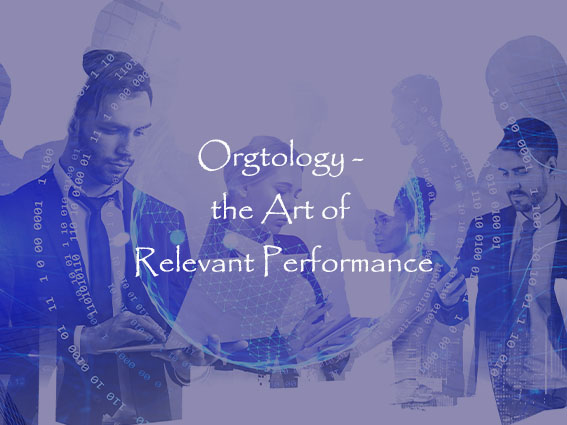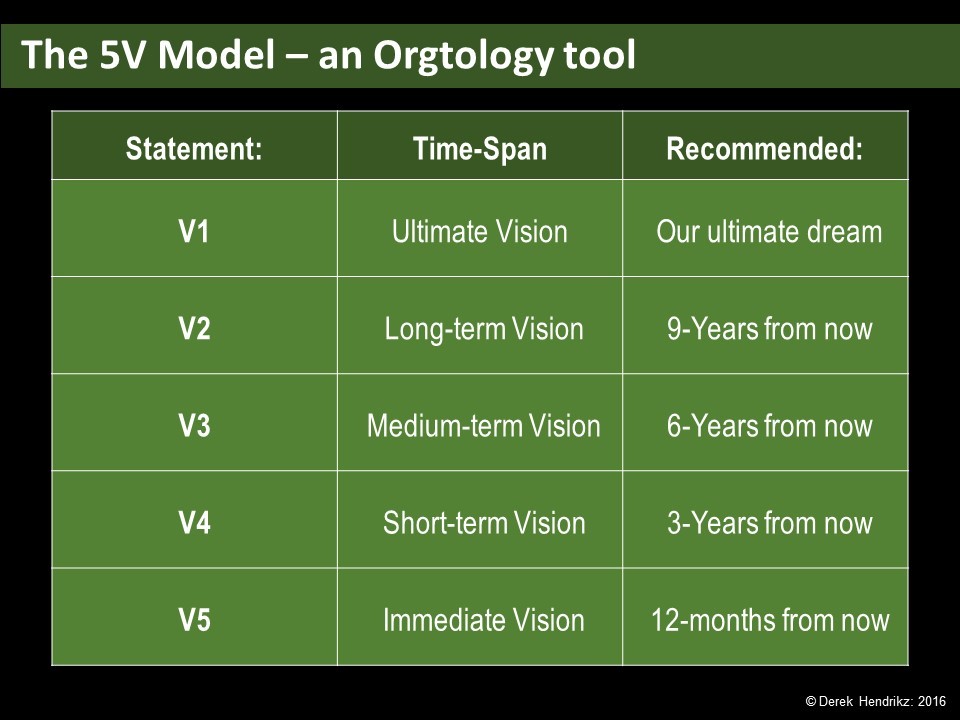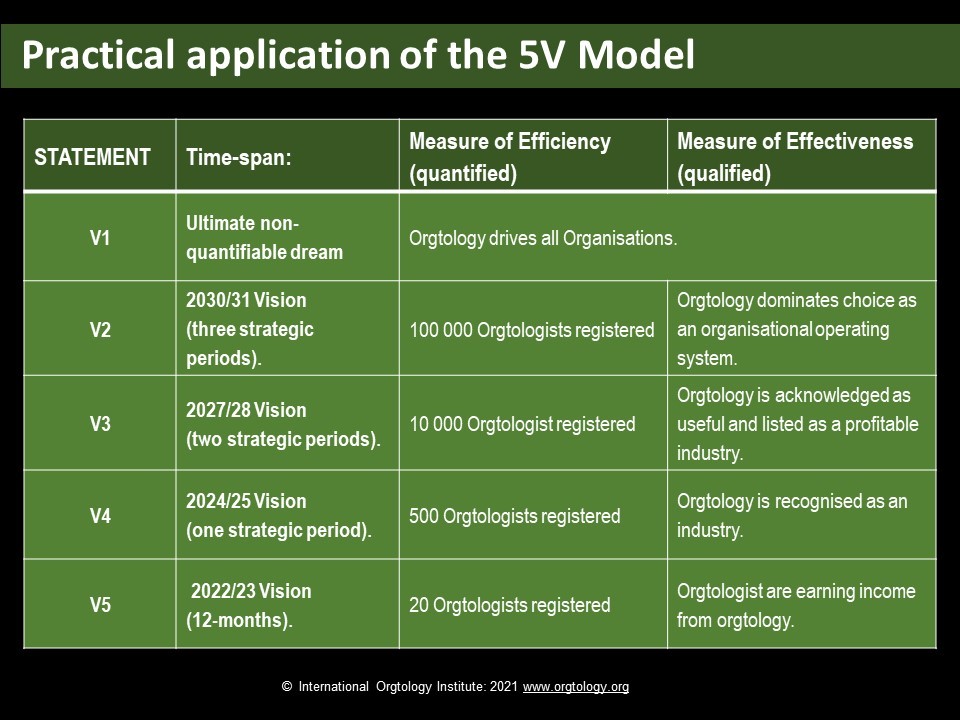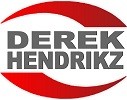The Orgtology Blog
The 5V Model – creating vision that drives strategy
Intent creates a future. It is taking nothing and turning it into something. In the world of Org, everything begins with intent and continues through purpose.
Vision creates intent whilst mission defines purpose. Vision is the desired state of Org. A strategy is the game plan. In so, the entire project construct of Org aims to execute its vision. Unlike a mission, a vision is something that we want to "kill". Its relevance is a constant reminder that we must change. It tells us that we are not where we want to be, and it drives us towards a new reality. One that we have created through thought. A vision statement is thus the key driver to strategic success.
I often hear the argument that vision is where we want to go, and mission is how we will get there. That is how most business schools explain their difference. Although this statement holds some truth, it is not an entire truth. If mission gets you to where you want to be, then what will be the point of a strategy? The terms "vision" and "mission" are confusing since there are numerous ways to grasp them. That is why we promote the terms "intent" and "purpose". The distinction between these two are clear. In so, it would make more sense to say: "Purpose is what we are, and intent is what we want to do with that". This is a clearly stated relationship that creates a sustainable eco-system. Effective strategy depends on a good understanding of this cycle. The aim of strategy is to expand the relevance of purpose and to execute intent.
Intent is the creator of all organisations. Great organisations = great intent. The greater the intent, the greater the return. If the return is useful, it will also lead to greater endorsement, which in turn will lead to a greater lifespan. E.g., the vision of Disney – "Happiest place in the world" has driven them to become one of the world's top ten brands. It has created immense relevance for their aim, which is family entertainment. Vision is what separates humans from most animals. Therefore, it is something incredibly powerful.
Basic assumption of the 5V Model
If vision drives strategy, then it is important to link the future to the moment, because we will always execute strategy on a timeline.
The basic problem with vision driving strategy is that we also want a vision that does not expire. It should indefinitely drive Org. In so, vision statements are often so far removed from current reality that it can never be a realistic measure for strategic success. I.e., we mostly have no idea on whether we are getting closer or not.
For that reason, the above assumption states that we must link the future to the present. I.e., we must bring our vision closer to now. To do this, the 5V model has five visions (5 V's). Each "V" brings the ultimate dream closer to now.
Understanding the 5V Model
A problem that most vision statements have, is that they are mostly beyond reach. I.e., they are often too vague to drive a meaningful strategy. E.g., the South African Police Service has a vision of a safe and secure environment for all people in in the country. With about fifty murders per day, they are still light years away from that. In this case it would make sense to bring their intent closer to a reality. One must do this without losing sight of the ultimate desire. To illustrate this, think about stretching an elastic band between your two hands. If you stretch too far it will snap. To close and it will hang loose. What we want to do with vision and current reality is to create a healthy tension. One that will stretch the organisation without breaking it.
During 2015, I created the 5V Model to work with this problem. Through 5V, we create five vision statements. The first one (V1) is an "utopia" vision, similar to the police example above. Because V1 has no time-span, it is our ultimate vision. V2 is aimed at a long term e.g., 9-years from now. V3 will be for a medium term, e.g., 6-years from now; and V4 is short term, e.g., 3-years from now. V4 shows the end of the current strategic period. V5, the last statement, is within the next 12-months. In this way we create a ladder of strategic intent. Moreover, the 5V Model also becomes a measure of strategic success. It is one of the oldest models that orgtology holds. I use it in all my strategy development projects with amazing success. It works.
The best way to create the five visions, is from the top down. In other words, it is best to work from an ultimate and non-quantifiable dream to more realistic goals. Not the other way around. If you begin at a realistic place, you might want to keep it that way. The whole point of a dream is to not be real.
The purpose of a strategic period
Old school thinking around this is that a strategic period is the period within which an organisation executes its strategy. From an orgtology perspective we see a strategic period as a milestone for a rolling strategy. I.e., we are constantly strategizing towards our ultimate dream.
A strategic period also gives us a goal against which we can measure the effectiveness of our executive team and their governing board. In so, a strategic period measures the success of Org's leadership construct. Yet, this does not in any way imply that a strategy is ever completely executed. At least not if it is driven by a faraway dream. Executing a strategy thus never ends. It is a process that we run through projects.
In orgtology, we generically recommend a 3-year strategic period. To most organisations this should be ideal. More than three-years makes prediction difficult to impossible, especially in our current fast changing world. Less makes it difficult for organisations to execute.
V1 – The Ultimate Vision...
This is the ultimate utopia for Org. It is a definitive aspiration. One does not want to limit V1, so, one must not quantify it. It serves as a supreme dream. This is an intent that the organisation will always be working towards. It must be unattainable at the point of creation.
The best way to write a V1 statement is to first define a state of absolute chaos. Define "hell" and it will make your "heaven" clear. In that way you will know how to stay as far as possible from "hell''. The flip-side of absolute chaos is total order. Org exists somewhere between the two. With purpose as the focal point, define the opposite of total chaos and you have a V1.
V2 – Three strategic periods from now…
Here we ask the question; "Where should we be 9 years from now to get closer to V1?"
The aim of V2 is to create a quantifiable super goal that will get us as close as possible to our ultimate vision.
V2 is a long-term vision, and it will lead us in a realistic way. 9-Years is a wide span, so the dream can still be big. V2 will give specific guidance to V3.
The recommended period for V2 is 9-years.
V3 – Two strategic periods from now…
Here we ask the question; "Where should we be 6 years from now, if we want to achieve V2?"
The aim of V3 is to create a quantifiable super goal that will ensure that we get to V2. It is a medium-term vision. The timespan is medium and the dream must be defined in that way. V3 sets the table for V4.
The recommended period for V3 is 6-years.
V4 – One strategic period…
V4 is both urgent and important to the 5V construct. It typifies the end of a current strategic period. It is thus our short-term vision.
As a rule of thumb, I would say that more than 60% of Org's strategic programs and projects should aim to achieve V4. When a board of directors approve a strategy, V4 must be closely scrutinised. It aims to achieve quick results. We will mostly measure our strategic completion against the achievement of V4. If we are not getting any closer, we must change our strategic activity. In that, V4 is our strategic goal, and achieving it will show our strategic success.
A ROET analysis will always precede V4. ROET is an orgtology model that we use to analyse Relationships, Opportunities, Efficiency, and Threats. It shows what to strategically focus on. In so, it also helps to define V4.
It is important to note that V4 does not depend on V3. We must often revisit the V2 and V3 statements after we have moulded a V4. The ROET should give a very realistic status quo of what we can and cannot do. Therefore, V4 is an extremely specific and realistic intent. Our aim must be to precisely execute V4 within our current strategic period.
The recommended period for V4 is 3-years.
V5 – By the end of this year…
V5 is simply our annual super goal. It turns V4 into a chewable chunk. We must achieve and revise it on an annual basis.
The recommended period for V5 is 1-year.
Practical Application
Vision statements often create vague intent. E.g., "innovative bank", "agile products", "robust operations", etc. A vision statement does not have to be quantifiable at V1 level, but it must give a clear idea of what we are chasing. E.g., "100% voluntary compliance" is an excellent vision statement for a revenue authority. In so, "all end-user hardware runs on our operating system" is a good vision for an operating systems software company. These last mentioned two visions create a state that is close to impossible to achieve, but we will know if it does happen.
When defining the 5V Model, we create one statement for V1, but two statements for V2, V3, V4, and V5. Reason being is that V1 is our ultimate dream. To get there we must both quantify and qualify. In so, V2 to V5 has two statements, one that quantifies and one that qualifies.
The attached table shows how we do this.
Conclusion
The 5V model creates a powerful relationship between purpose and intent. Intent is the disruptor. Like a rudder, it changes the direction of a ship, but it should not change the nature of the ship. Where intent attempts to overthrow purpose, a duel is called. Either intent or purpose will die during this battle. Of course, where one dies, a new purpose or intent is born.
From a practical perspective, strategy has the task to keep operations relevant. I.e., we create change that will propel prosperity. Through the 5V Model we ensure longevity for Org by chunking down our ultimate vision, which is our most relevant state.
In my experience, a strong 5V brings Org to the moment. Its like positive and negative magnetic forces. From an orgtology perspective, these forces represent the strength at which projective and receptive elements draw each other. This is a strange phenomenon where a clearly defined future inevitably creates an immediate focus. It creates a powerful consciousness of the current moment. In so, we begin to focus on urgent and important things. We thus stop wasting time on nonsensical things. That is the power of 5V.

Join the Orgtologist Certification Program (OCP) - Empowering Executive Teams Worldwide
Copyright
© 2019 CFT Hendrikz
When you subscribe to the blog, we will send you an e-mail when there are new updates on the site so you wouldn't miss them.




